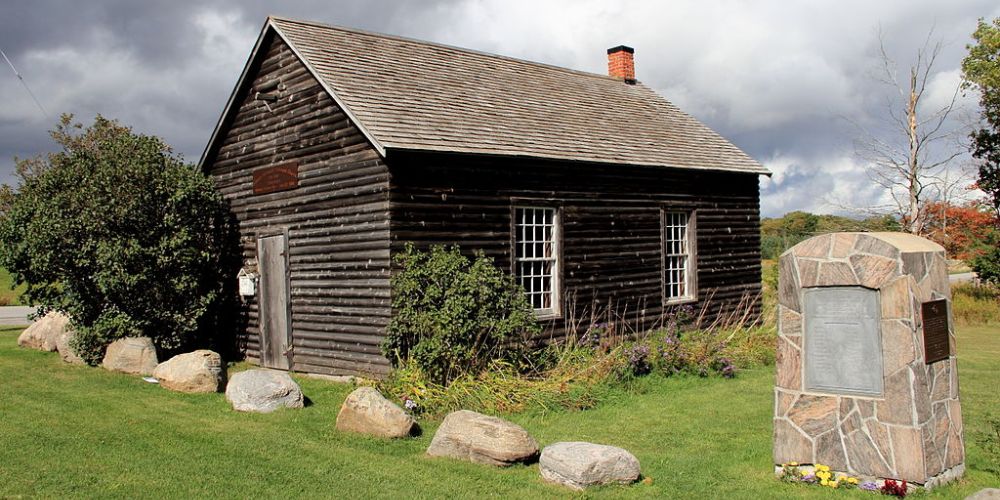The History Behind The Oro African Methodist Episcopal Church

In 1849, the Oro African Church was built on what is now 1645 Line 3 N in Oro-Medonte. A symbol of freedom, the building is the last remainder of one of the oldest African-Canadian settlements in Upper Canada.
While no longer in use, the church is a testament to the role African-Canadians played in the War of 1812.
How The Oro African Community Began
When the War of 1812 broke out, Black soldiers joined the Upper Canadian militia as part of Captain Runchey’s Company of Coloured Men.
Commonly referred to as the Coloured Corp, the company, made up of free Blacks and indentured Black slaves, was formed at the request of Richard Pierpoint.
Richard Pierpoint
Pierpoint was taken from Africa at 16 years old and sold to a British officer in the US. He was enslaved for close to 20 years before regaining his freedom during the American Revolution. According to records, Pierpoint was stationed with a Loyalist unit known as Butler’s Rangers in the Niagara region in 1780.
Following the American Revolution, he was granted 200 acres in Grantham Township (now known as St. Catherines.) This amount of acreage was the same that would have been received by an officer. It was double that of a private.
During his time in Grantham Township, Pierpoint petitioned Lieutenant-Governor John Graves Simcoe to give Black settlers the ability to settle next to each other and on a tract of land away from White settlers. The petition was denied and in 1806, only two years after clearing his land and receiving patents for his land, he sold his lots.
When the War of 1812 began, Pierpoint was 68 years old. Ready to fight, he petitioned the British for an all-Black Unit. Soon after, Pierpoint joined Captain Robert Runchey’s Corps of Coloured Men.
Runchey was a poor leader. He would segregate his Black men from other militiamen and would even hire out Black soldiers to be domestic servants to officers. Among his superiors, he was said to be a “worthless, troublesome malcontent.”
Still, the Coloured Corp saw many battles and played a significant role in the war.
Following the War of 1812, the British granted around 25 plots of land in Oro to Black settlers. This included 11 former soldiers of Captain Runchey’s Company of Coloured Men.
RELATED: “Lost Heroes of Oro” musical shines light on local Black hero Richard Pierpoint …
The Oro African Church Is Built
While it wasn’t the largest, the Oro African community was the only government sponsored Black Settlement in Upper Canada. It was set up to help secure defense of the northern frontier and provide support to the fort in Penetanguishene if the war with the US reignited.
By 1831, only 8 of the grant recipients had settled in Oro. Over time, however, the settlement grew and soon nearly 100 Black people were calling this small Oro Medonte community their home.
One of the settlers who had accepted the Crown grant in 1829 was Noah Morris. In 1945, Morris transferred an acre of his land to the Religious Society of coloured African Episcopal Methodist Church in Canada so that it could be used for a church and burial ground.
Soon after, work began on the church. A simple log structure, the building sits at the corner of what is now Line 3 and Side Road 10/11. Next to the church is an unmarked cemetery.
Reverend R.S.W. Sorrick
Up to this point, Reverend Ari Raymond was the monster in Oro for both black and white people. But, around the same time that the land came available for a church, a Reverend by the name of R.S.W. Sorrick had made his way to the community in Oro.
Sorrick was born enslaved in Maryland, US and sold multiple times. At 25 he was sent to prison for preaching gospel. He was in prison for 3 months and 8 days before being purchased by one of his previous owners. In his first hand account, Sorrick refers to this owner as Mr. H.
Believing that Sorrick has a call to preach, Mr. He offered Sorrick his freedom if he promised to send him $400. Sorrick accepted.
In 1845, Sorrick made his way to Oro by way of Toronto.
When reflecting back on his time in Oro, Sorrick recalled, “I went to Oro, where I found some fifty persons settled; many comfortable and doing well, but many suffer a great deal from poverty. I showed them about agriculture, and instructed them as far as my limited learning would go. When I came away, many were poor, but they were not vicious: I never lived among a more teachable people. I never knew a fight among them or their children. The worst fault was, some tendency to slander each other: but they have been instructed by the missionaries to read and write.”
Sorrick served until 1847.
The Church Closes
While the area is well-loved today, in the 1900s, Oro-Medonte was remote, the climate was harsh, and the soil was poor. By 1900, the community had all but dissolved and the church became inactive.
No longer in use, the church fell into disrepair and, in 1916, the building was declared abandoned by the British Methodist Episcopal Church.
In 1949, the church was restored. Then in 2000, the Oro African Church was declared a Historical Site, with extensive renovations completed in 2016.
The Oro African Methodist Episcopal Church stands as a powerful symbol of resilience and perseverance in the face of adversity. From its roots in the War of 1812, where Black soldiers like Richard Pierpoint played a vital role, to the establishment of the Oro African community, this church embodies the enduring spirit of the African-Canadian settlers in Upper Canada.
PHOTO CREDIT – Title: OroAfricanMethodistEpiscopalChurch,ON-1. Author: Terry Snyder. Source: Wikimedia
Beat FOMO by being in the know!
Sign up for our newsletter today and never miss a beat.







